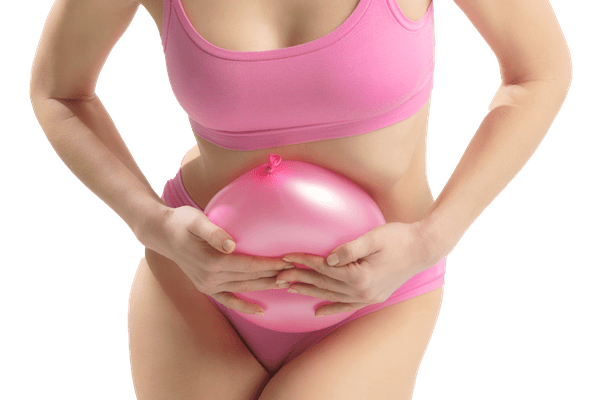
Bloated? It could be uterine fibroids.
Take charge of your health
Understand fibroids, their symptoms, and uterine-sparing treatment options. Stop suffering and start living. Better is possible.

Don’t let fibroids cramp your style
Did you know that up to 77% of women will develop fibroids in their lifetime.1
Fibroids are benign growths that develop in or around the uterus. They can vary in size and location and may lead to abnormal uterine bleeding (AUB). If you’re experiencing any of the following, it could be fibroids.
- Heavy, prolonged or painful periods
- Pressure in the pelvis and bloating in the lower abdomen
- Feeling tired or sluggish
If heavy bleeding or bloating is making you second-guess your outfit or interrupting your everyday life, know that you have options. Together with your doctor, find symptom relief that fits your lifestyle.
Better starts here.

Common Fibroid Symptoms
Heavy menstrual bleeding
Abdominal bloating and cramping
Pelvic, back and leg pain
Pain during sex
Frequent urination
Fatigue
Fibroids 101
What are Fibroids?
Fibroids are noncancerous tumors that grow in or around the uterus and form when a cell goes rogue and replicates over time.
Apples, oranges, fibroids, oh my!
Fibroids can be as big as a watermelon or as small as a pea, and still be very disruptive. They can cause abdominal distension and make your belly bulge like you’re pregnant when you’re not.
They are measured by diameter in centimeters, while the uterus (including fibroids) is measured in comparison to the number of weeks a pregnant woman’s uterus (including fetus) would be. The chart below illustrates these measurements in comparison to common fruits.

This diagram is used to illustrate approximate sizes and diameters of a single fibroid based on average fruit sizes. It does not reflect clinical data.
Your guide to fibroids
Fibroids are classified by their location and the symptoms and severity depend on both the location and size of the fibroids.3
| Fibroid type | Uterus location |
|---|---|
| A. Pedunculated | Connected by a stalk-like stem |
| B. Subserosal fibroid | On the outer uterus wall |
| C. Submucosal fibroid | Inside the uterine cavity |
| D. Intramural fibroid | Within the uterus walls |
Your physician will help determine which treatment is best depending on the size, location and symptoms of the fibroid.
Understand your symptoms
Get to know your body. Take our quiz to better understand what your symptoms might be trying to tell you.
Treatment Options
Better is possible™
Together with your doctor we can help make a better life your reality.
Historically, watchful waiting, medication and hysterectomies were the only solution for treating fibroids and AUB. Now you have options. Keep your uterus and find symptom relief with minimally-invasive, non-hormonal procedures that require minimal downtime. Ask your doctor if these treatments could be right for you.
Abnormal periods disrupting your life?
Learn the difference between normal vs. heavy periods.
If your period is irregular in frequency, regularity, duration and volume, you may be experiencing abnormal uterine bleeding, also known as menometrorrhagia. This can be caused by fibroids, polyps, or other uterine conditions. Is your ‘normal’ actually normal?
You have options
If you’re feeling unsure about what to do next or need help finding a doctor, don’t worry – we’ve got you covered.
Find Relief
Locate a physician with minimally-invasive procedures near you
Know Your Options
Explore procedures that treat your symptoms and fit your lifestyle
Assess Your Period
Find out if your period is actually ‘normal’
Understand the Uterus
Get familiar with the uterus, how it works, and why uterine health is important.
Frequently Asked Questions
Are all fibroids symptomatic?
Not all fibroids come with symptoms. In fact, it’s very common for women to have asymptomatic fibroids.11
Do all fibroids need medical treatment?
If fibroids do not present symptoms or negative implications for a woman’s health, they may not need treatment. Women should consult their doctor to determine the best path forward.
Can fibroids impact fertility?
Fibroids can affect a woman’s ability to conceive.11 If women are facing reproductive trouble, they should talk with a doctor to explore diagnostic tests, which help to determine the cause for infertility.
Are fibroids hereditary?
While there is no causal link between genetics and fibroids, research findings lead physicians to believe there is a genetic component to a woman’s susceptibility to developing fibroids.12 Having a family member with fibroids increases risk – if your mother had fibroids, your risk of also experiencing them is roughly three times higher than someone who does not have fibroids in her family.13
Are there more treatment options for fibroids other than hysterectomy?
Advances in medicine have led to a number of treatment options–including non-surgical methods like birth control pills or IUD, as well as minimally invasive surgeries like laparoscopic radiofrequency ablation, laparoscopic myomectomy, and hysteroscopic myomectomy.11, 13 Treatment for fibroids depends on the size, volume and severity of fibroids, as well as a woman’s health and lifestyle preferences.
Join our community
Women are often told pain and heavy bleeding are a normal part of their cycle. We know that’s not the case. Advocating for your health starts with knowing your body. We’re here to help you to take your first steps toward better.
Get to #KnowYourU (uterus) and find care that’s best for you!

** MyoSure Manual is not indicated for the treatment of fibroids
References
- Johns Hopkins Medicine. https://www.hopkinsmedicine.org/health/conditions-and-diseases/uterine-fibroids. Accessed June, 2025. ↩︎
- Borah, Bijan J. et al. The impact of uterine leiomyomas: a national survey of affected women, American Journal of Obstetrics & Gynecology, October 2013, Volume 209, Issue 4, 319.
e1—319.e20. Wise LA, Laughlin-Tommaso SK. Clin Obstet Gynecol. 2016;59(1):2-24. Alexander AL, et al. Obstet Gynecol. 2019;133(1):6-12. ↩︎ - UNC School of Medicine. (2020). Fibroid Tumors. Retrieved from https://www.med.unc.edu/obgyn/migs/our-services/what-kinds-of- problems-do-the-doctors-in-this-group-treat/fibroid-tumors. ↩︎
- Sonata IFU. ↩︎
- Acessa IFU. ↩︎
- Hologic data on file, VER-04869. ↩︎
- Hologic data on file, VER-13652. ↩︎
- Hologic data on file, VER-11742. ↩︎
- Hologic data on file, VER-11786. ↩︎
- Hologic data on file, VER-11576. ↩︎
- Mayo Clinic. Uterine Fibroids: Symptoms & Causes https://www.mayoclinic.org/diseases-conditions/uterine-fibroids/symptoms-causes/syc-20354288. Accessed March 10, 2021. ↩︎
- Eggert SL, Huyck KL, Somasundaram P, et al. Genome-wide linkage and association analyses implicate FASN in predisposition to uterine leiomyomata. Am J Hum Genet. 2012; 91(4):621-628. doi:10.1016/j.ajhg.2012.08.009 ↩︎
- Office on Women’s Health. U.S. Department of Health & Human Services. Uterine Fibroid Fact Sheet. https://www.womenshealth.gov/a-z-topics/uterine-fibroids. Accessed March 10, 2021. ↩︎
Important Safety Information
The Acessa ProVu system is intended to identify and shrink symptomatic uterine fibroids. The Acessa ProVu system is used by trained physicians during laparoscopic surgery under general anesthesia. Rare but serious risks of this procedure include, but are not limited to, infection, internal injury, blood loss and complications related to laparoscopic surgery and/or general anesthesia. This procedure is not recommended for women who are planning future pregnancy. This information is not medical advice. Please discuss the risks and benefits with your doctor to find out if the Acessa procedure may be right for you.
MyoSure tissue removal system is intended to remove unwanted tissue from the uterus. During a MyoSure procedure, a trained gynecologist inserts the MyoSure device through your vagina and then removes the unwanted tissue from inside the uterus. Use of the MyoSure system is not appropriate for patients who are or may be pregnant, or have signs or symptoms of a pelvic infection, cervical cancer, or previously diagnosed uterine cancer. As with any surgical procedure, there are potential risks including but not limited to internal injury, excessive bleeding, and complications related to anesthesia. Temporary side effects may include cramping, bleeding, fever, and nausea. This information is not medical advice. Please discuss the risks and benefits with your doctor to find out if the MyoSure procedure may be right for you.
The Sonata System is intended for diagnostic intrauterine imaging and transcervical treatment of symptomatic uterine fibroids, including those associated with heavy menstrual bleeding. Common Side Effects include bleeding, spotting, cramping, and/or discharge. There are potential risks with this treatment such as skin burn and infection. Women who are pregnant, have a pelvic infection, are known or suspected to have gynecologic cancer, or have intratubal implants for sterilization should not have this procedure.



